|
|
|
Sort Order |
|
|
|
Items / Page
|
|
|
|
|
|
|
| Srl | Item |
| 1 |
ID:
141715
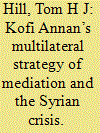

|
|
|
| 2 |
ID:
141716
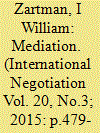

|
|
|
|
|
| Summary/Abstract |
A mutually hurting stalemate is a necessary but insufficient condition for the opening of negotiations, direct or mediated. It is subject to perception, buffered by many insulating ploys even if it seems to exist objectively. Thus, the major challenge for a mediator in most cases is to ripen the parties’ perceptions. In addition to the attitudinal challenge, there are structural challenges posed by other types of stalemates and near-stalemates, which call for not only persuasion but also manipulation by the mediator. The ultimate challenge to a mediator is to move successful negotiations producing conflict management onto the consummating phase of negotiations for conflict resolution. But the first removes the incentive for the second, since it ceases the violence that is the most effective source of pain.
|
|
|
|
|
|
|
|
|
|
|
|
|
|
|
|
| 3 |
ID:
141711
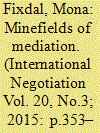

|
|
|
|
|
| Summary/Abstract |
This special issue explores significant problems of peace mediation. How do these “minefields of mediation” arise, how do mediators’ ways of handling them impact the negotiation process, and what can mediators do to overcome them? Using examples from the last quarter century, and from the Middle East in particular, the authors examine these questions at different stages of the mediation process, from its initiation to its culmination, and with reference to different forms of mediation, including facilitation, muscular, and multiparty mediation. This short introduction provides a systematic overview of some of the most pertinent mediation challenges, with reference to whothe mediators are, whenthe mediation takes place and whatthe issues of contention and possible outcomes are. These areas are of course all intertwined, and, as the articles in this issue point out, are also very much influenced by changes in the domestic, regional and international environment.
|
|
|
|
|
|
|
|
|
|
|
|
|
|
|
|
| 4 |
ID:
141717
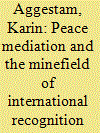

|
|
|
|
|
| Summary/Abstract |
This article analyzes the intricate dynamics between international mediation and the quest for recognition in protracted conflict. The overarching aim is two-fold: to analyze how the struggle for recognition relates to protracted conflict, and why, when and in what ways recognition poses a barrier to efficient peace diplomacy and mediation. The article explores how preferences and interests are infused with identity politics and claims for recognition. It advances three inter-related dimensions of recognition: ontological security, dignity and identity. The conceptual discussion utilizes empirical illustrations from the Israeli-Palestinian conflict. Three concluding remarks are made. First, international mediation may be accepted by negotiating parties to achieve international recognition rather than to reach an agreement. Second, due to the problem of recognition the notion of “ending conflict” can backfire in the mediation process. Third, mediators should focus on mutual, but thin recognition towards greater acknowledgement of the untenable and vulnerable positions the parties hold in conflict.
|
|
|
|
|
|
|
|
|
|
|
|
|
|
|
|
| 5 |
ID:
141712


|
|
|
|
|
| Summary/Abstract |
Multiparty mediation, which occurs when two or more third parties cooperate or compete in helping antagonists negotiate a conflict settlement, carries both risks and rewards as a conflict management strategy. Cooperating multiple third parties can increase the chances of crafting an agreement, band together to create greater pressure on the conflict parties to reach agreement, and supply outside resources to help implement the negotiated agreement. Competing multiple third parties can undercut each other, prolonging the conflict and allowing antagonists to resist necessary compromises and negotiated concessions. This article examines the changing environment for multiparty mediation and the impact of five changes that affect the practice of mediation. It derives some interim conclusions about where the field is heading and offers some recommendations for making multiparty engagements more effective.
|
|
|
|
|
|
|
|
|
|
|
|
|
|
|
|
| 6 |
ID:
141714


|
|
|
|
|
| Summary/Abstract |
The present study challenges three common assumptions of the international mediation literature. First, it challenges the perception that pure or weak mediators are unable to use manipulative and coercive strategies in the mediation process, but can only resort to facilitating the dialogue and at most formulating a proposal on behalf of the disputants. Secondly, it challenges the perception that only resource-based power can be used to manipulate the process and coerce (and direct) the parties toward mutually acceptable solutions. This misconception is based on the assumption that the expansion of the zone of possible agreement, which is mainly attributed to manipulative strategies, can be achieved only by the employment of carrots and sticks which are often inaccessible to pure or weak mediators. Lastly, it shows how this type of leverage can also indicate a particular bias that an apparent pure mediator might have: bias of outcome.
|
|
|
|
|
|
|
|
|
|
|
|
|
|
|
|
| 7 |
ID:
141713
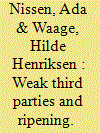

|
|
|
|
|
| Summary/Abstract |
Can weak third parties contribute to ripening conflicts for resolution despite their lack of leverage? According to the core principles of ripeness theory, mediators with leverage have a clear advantage when it comes to ripening. What is often overlooked in the literature, however, is the important ways a weak mediator can contribute to ripening as well. This article explores two noteworthy cases of weak third party ripening – the Norwegian roles in the Oslo channel between Israel and the Palestinians, and between the URNGguerrilla and the government in Guatemala. These cases demonstrate how careful interventions by weak third parties can help disputants see negotiations as a way out both in preliminary and later phases of negotiations. However, we also argue that weak third parties should not get involved in ripening unless they can call on a mediator with more leverage once substantial negotiations begin.
|
|
|
|
|
|
|
|
|
|
|
|
|
|
|
|
|
|
|
|
|